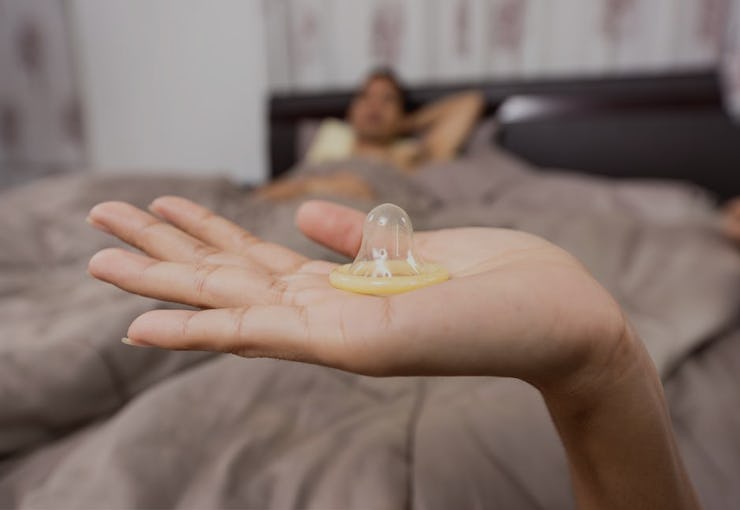The Biggest Change to Condoms in 50 Years Is Sticky in a Good Way
"Poor lubrication encourages condom misuse."

Public health researchers are trying to do the impossible: get people to actually use condoms. And they may have just cracked the code.
For better or for worse, the male condom is currently the only available contraceptive method that protects against pregnancy and most sexually transmitted infections. Despite this fact, many people persistently misuse condoms — or don’t use them at all. As a result, sexually transmitted infections are on the rise. To combat this situation, researchers at Boston University have invented a new and improved condom with a key quirk they hope people will actually want to use.
In a study published Tuesday in Royal Society Open Science, the interdisciplinary research team announced that what makes this condom different than the rest is self-lubrication. While most condoms come with an added silicone-based lubricant, this newly designed condom is coated in polymers. The polymers capture moisture from water and bodily fluids, trap them on the condom surface, and cause the condom to become continuously lubricated. That’s important because surveys have shown that some people don’t use condoms because they say they create too much friction.
Study co-author Stacy Chin, Ph.D., worked on the polymer coating as a graduate research assistant at Boston University.
“Poor lubrication encourages condom misuse,” she said Thursday. Chin says her team reasoned that if they could “improve comfort for users, we can enable them to wear condoms more consistently and appropriately, preventing STIs and unplanned pregnancies.”
A traditional condom and a new coated condom.
Chin is now the CEO and co-founder of HydroGlyde Coatings, a Boston University-affiliated startup that hopes to bring these condoms to consumers. As of now, they have yet to be test-driven by users, but they were a hit during the study’s “touch test.” When 33 participants were asked to touch a standard latex condom, that same condom complete with conventional lube, and the self-lubricated condom, 73 percent expressed a preference for the new condom.
Chin and her co-authors write that these participants agreed that “an inherently slippery condom that remained slippery for a long duration would increase their condom usage,” and they argue that “such a coating shows potential to be an effective strategy for decreasing friction-associated pain, increasing user satisfaction and increasing condom usage.”
An explanation of how the coating scheme works.
Increasing condom usage is exactly what public health officials want — and it’s what drove the creation of the condom. A $100,000 grant from the Bill & Melinda Gates Foundation paid for the condom’s invention as part of the foundation’s mission to increase condom use around the world.
When used consistently and correctly, condoms are highly effective in preventing STDs and 98 percent effective at preventing pregnancy — although Planned Parenthood says that number is closer to 85 percent effective because people don’t always use condoms right. Regardless, in the United States between 2011 and 2015, just 14.8 percent of women and 19 percent of men between the ages of 15 and 44 used a condom “every time” they had intercourse in the past 12 months.
Experts believe insufficient condom use is the reason that Americans are currently infected with the highest number of STDs since the CDC started keeping track. In 2017, there were approximately 2 million new case of gonorrhea, syphilis, and chlamydia.
American STD rates are steadily increasing year by year — but that doesn’t have to be the case. People can just put on a condom. If one needs help figuring out how to put on a condom, look here. And if one is hoping to just stick it out until stickier condoms are available, they’ll be waiting for a while: Self-lubricating condoms will be on the market in about two years.